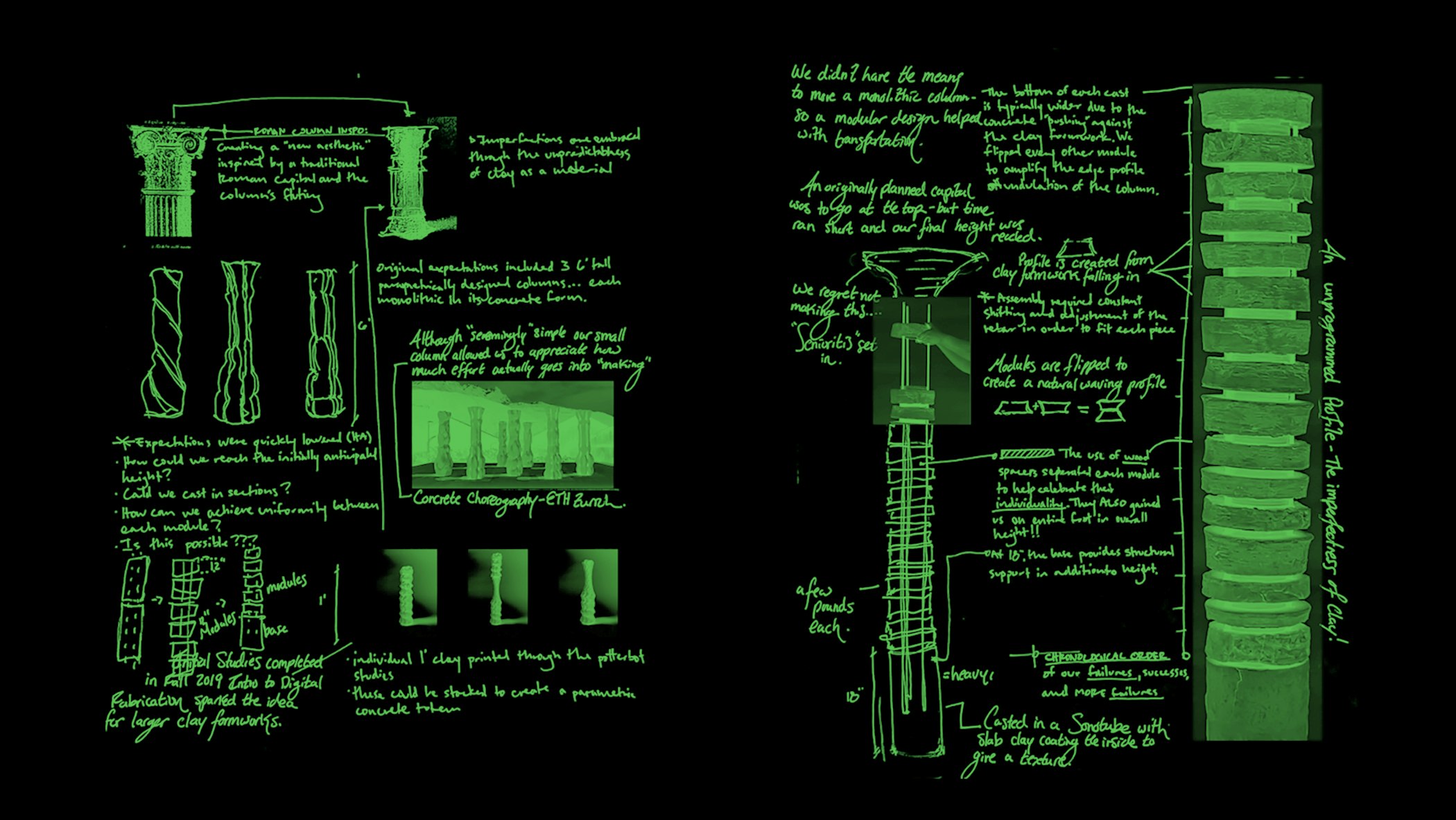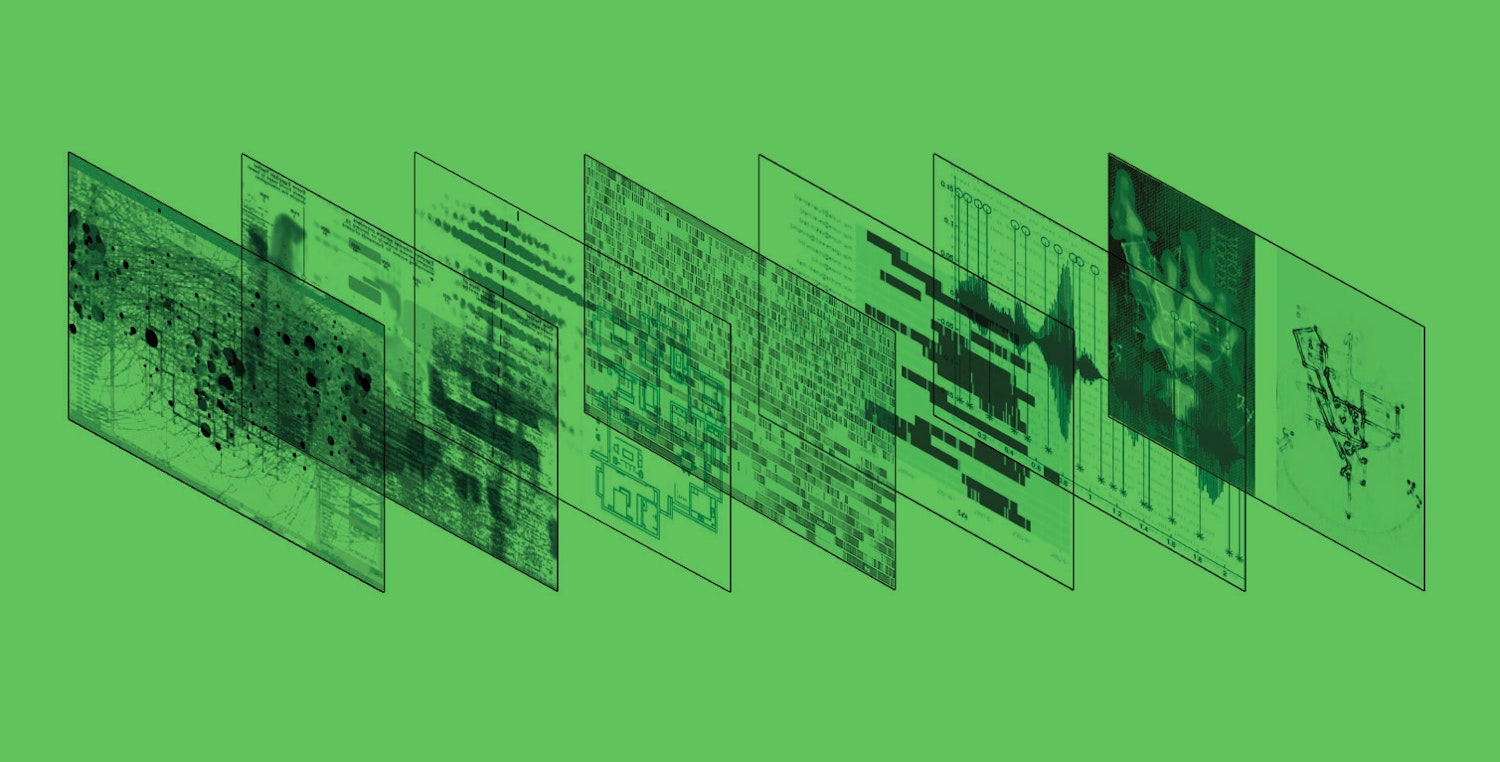- Kathy Velikov (KV)
-
I am here with Shelby Doyle, who is the Stan G. Thurston Professor in Design-Build and Director of the Architectural Robotics Lab at Iowa State University College of Design. She is also a Member of the Board of ACADIA (Association for Computer Aided Design in Architecture). Shelby, why don't start by talking about where you are right now, and some of the things that you're currently working on.
- Shelby Doyle (SD)
-
What I’m working on currently is launching a cultural history project for ACADIA on behalf of the Board: looking at the last 40 years as a way to think about the next 40 years of the organization. The first initiative of this cultural history project is a digital archive. While the individual papers are available on CumInCAD[1], having the full proceedings available to researchers allows for an additional layer of cultural history, and brings context to the evolution of computational design and computational design thinking.
It’s been exciting to spend time in the archive, and to see how the approach to computational design has changed (and not changed) over the last 40 years. The community began with questions of pedagogy—as computers made their way into design schools—and transitioned to current themes such as disciplinarity, legibility, and critical computation.
The second thing I am working on is setting up the Architectural Robotics Lab (ARL) in the Student Innovation Center at Iowa State University (ISU), and thinking about ways to integrate digital fabrication and robotics into our undergraduate curriculum. As an extension of the Computation & Construction Lab (CCL), the ARL follows its central hypothesis: that computation in architecture is a material, pedagogical, and social project; computation is both informed by and productive of architectural cultures. This hypothesis is explored through the fabrication of built projects, and materialized in computational practices. We are also invested in questioning the role of education and pedagogy in replicating existing technological inequities, and in pursuing the potential for architectural computation as a space of—and for—gender equity [Fig. 1].
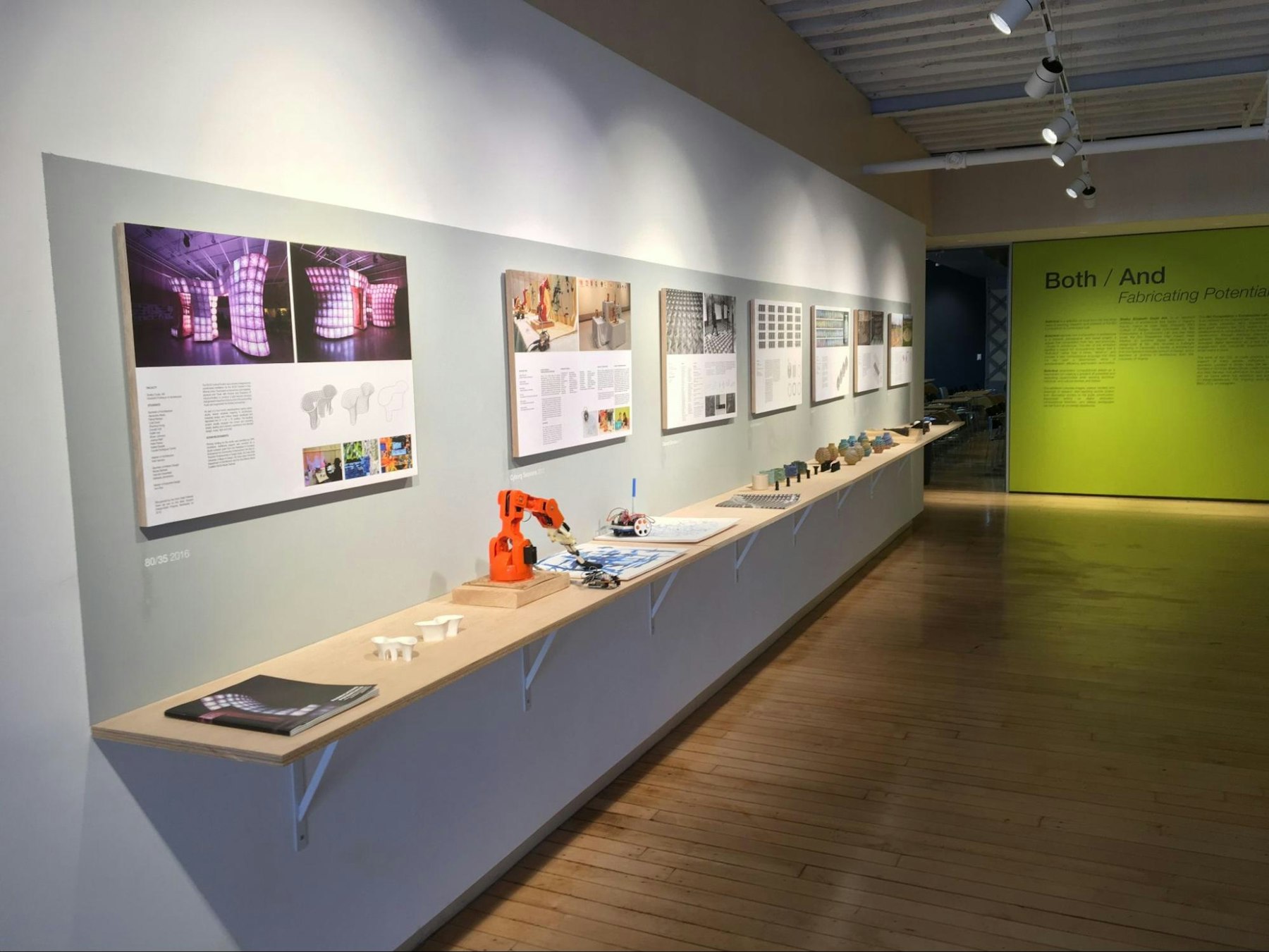
[Fig. 1] Image of Both / And: Fabricating Potentials exhibition at the Rhode Island School of Design in 2018 featuring the first 3 years of the CCL. © Image: Doyle
- SD
-
At ISU we have a primarily undergraduate body of students, so a lot of the pedagogical work I've been doing is to take digital fabrication and robotics technologies—which are often only available to graduate students—and seeing if we can make these technologies work in an undergraduate curriculum. This is a particular challenge in a five year accredited Bachelor of Architecture program, where there are already a lot of demands on students’ time to learn everything from history and theory, to building technology, to studio. Mostly I've taught digital fabrication and robotics as building technology, rather than as a separate discourse from capital “A” Architecture, which is sometimes a really challenging friction. But it's also been a productive way to work, because it means trying to wrestle with some of the more esoteric and speculative aspects of computational design in the frame of how we build buildings and how we think about construction.
- KV
-
I’m interested to hear more about how students, especially at the undergraduate level, engage with these ideas.
- SD
-
I like teaching undergrads because they don't have very many preconceived notions of what architecture is, and so they tend to be quite open to ideas. A lot of the work I’ve been doing has been trying to present technology as something that is “knowable”. I think one of the biggest issues with access to digital skills is that people write themselves out of the narrative. They say, “I’m not a technology person” and therefore they don't even take a class or even engage in a technique: so how do you even get someone to do that? One of the tricks that I've used is every time I buy a new piece of equipment and install it, I'll run a class around it. It's very intense teaching because I’m learning the equipment myself and designing a class in real time, but it has also been a good thing for me as an educator to be forced to ask: Why do we have these tools? What are we doing with them? Why is this in an architecture program? I think it's a question, then, given how many things an architecture student is supposed to know, or does this remain a rarefied body of knowledge? Or can it—or should it—ever be mainstream? And if you do say that now this is part of the accredited program, do you have to give up something else? For example, there is not enough space in the curriculum to teach things like the history and theory of computation like you can in a topic-specific Masters program. It’s been challenging—but also exciting—to see the work undergraduates do when brought into these discourses [Fig. 2–3].
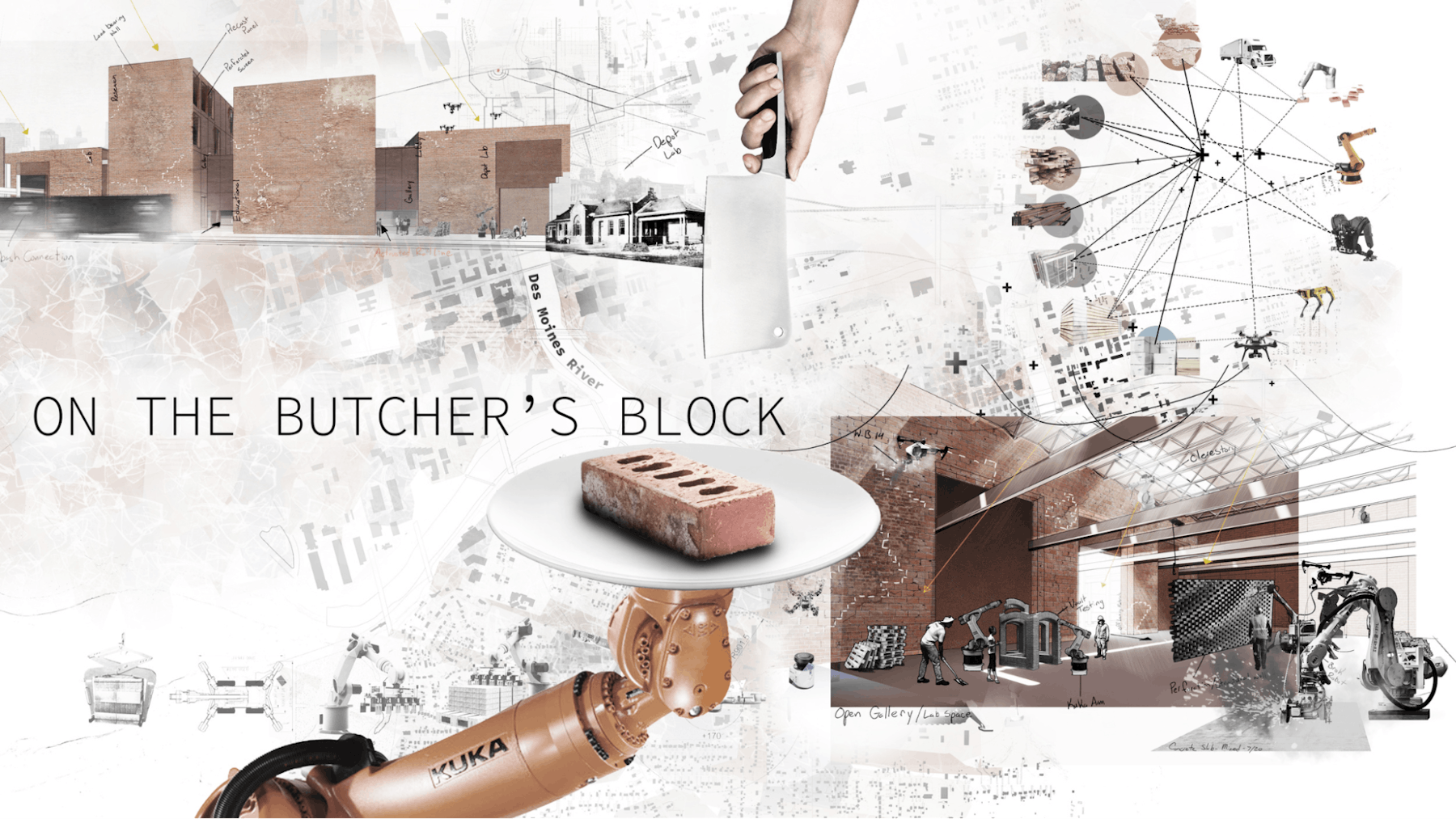
[Fig. 3] Mae Murphy and Cameron Wahlberg (ISU BArch ‘22), On the Butcher’s Block. Work completed in Fourth Year Studio in ISU Architecture in Fall 2020. © Image: Mae Murphy and Cameron Wahlberg – used with permission
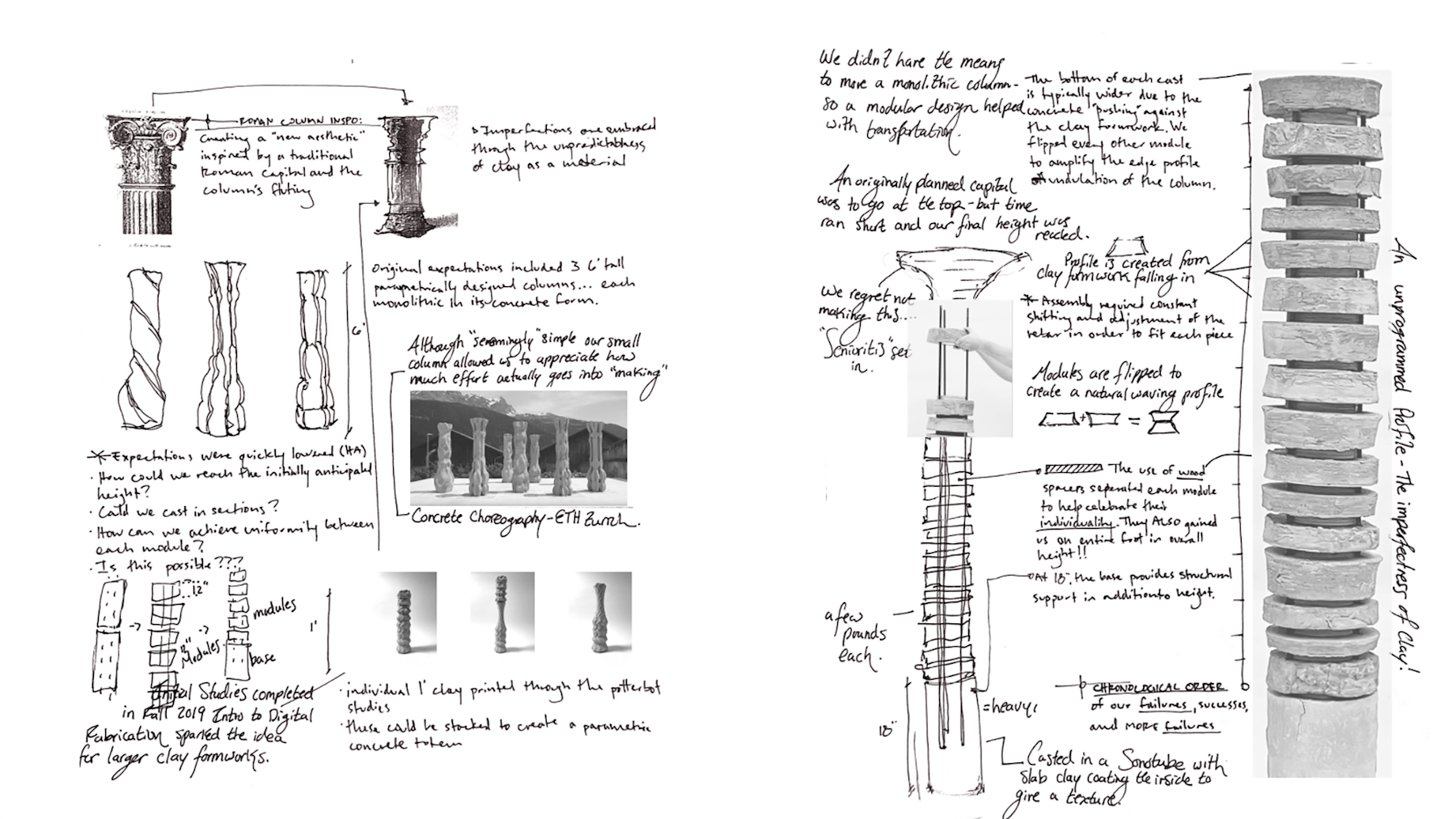
[Fig. 2] Jacob Gasper and Cyle King (ISU BArch ‘21), Robotic Clay Formwork. Presented as a Field Note at the ACADIA 2021 Conference. Work completed in an independent study at ISU in Spring 2021. © Image: Jacob Gasper and Cyle King – used with permission
- KV
-
In parallel to your research and your teaching, you have also been considering questions of authorship and contribution in computational design. Both with regard to the human contributors and the machinic ones. This really challenges the narrative of the singular hero author, which has been pervasive in architecture and architectural education for a long time. How does contemporary digital technology, particularly robotics, challenge the “author narrative”, and what's at stake here?
- SD
-
One thing that is exciting about digital technology is that when you are working with hardware and software you’re immediately in collaboration with someone who authored that hardware or software. Every time any of us open Grasshopper or Rhino, we’re in a long-distance and cross time collaboration with Bob McNeel and his team of engineers (Rhino), or with David Rutten (Grasshopper) and the entire community of plug-in designers (Food4Rhino). These weren't things that emerged magically. They were tools that someone created. And I think there's something really exciting about that because it means that you really can't disentangle the work that you do from a larger community or body of people. You can’t be a lone genius. That’s actually impossible. I think there's something nice about being able to just escape that trap of thinking about any of us working in isolation, because it's always been fiction.
I think robotics and digital fabrication tools reveal that fiction. There’s a lot of folks who do really beautiful work in this area, such as Madeline Gannon, Sougwen Chung, or Maria Yablonina. They are designers who are working with a robot and they each speak about ways of collaborating with the technology. That's not to anthropomorphize the robots, but to think more carefully about how as humans we engage with forms of labor, each other, and the environment. I think there's a lot of ecological ethics that you can bring into those conversations about our relationship as individuals to larger, collective systems [Fig. 1].
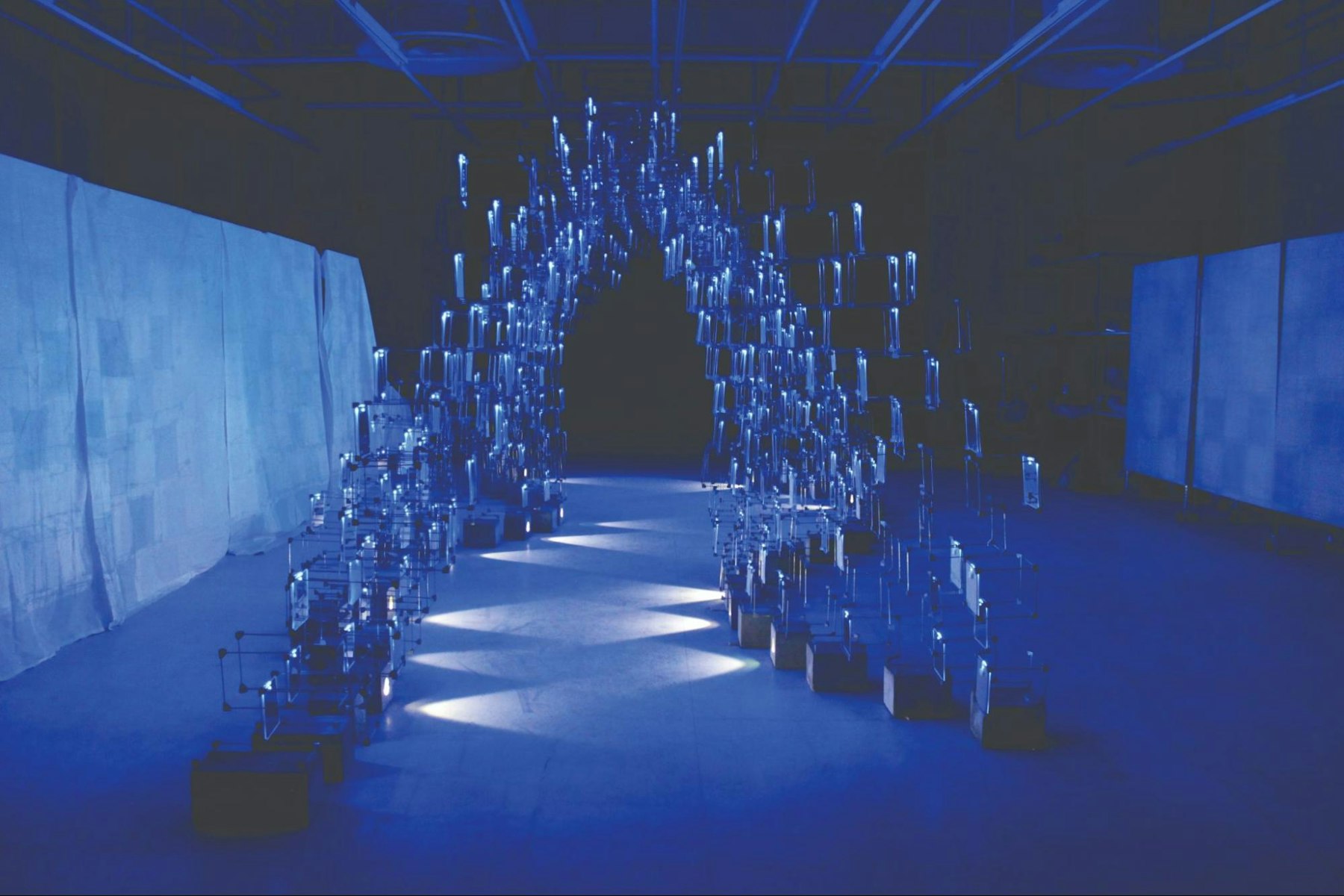
Figure 4. The IM_RU Pavilion addresses the relationship between architecture and public space, where an individual is simultaneously confronted with a multiplicity of individual and collective perceptions The project relied upon low-cost PLA joints fabricated quickly on four low-cost ($800) Dremel 3D printers: 18 cents per joint and 14.25 minutes to print. All materials for the project totaled $4,200. In doing so, this project also challenges the expected costs of built computational projects, a parameter that often keeps these technologies cloistered in specific institutions and communities. © Doyle
- KV
-
This makes me think of theories in Science and Technology Studies, such as actor-network theory, where philosophers like Bruno Latour are working on recreating narratives of invention and innovation in science through a flattening of hierarchies; through considering not only human actors, but also the agency of nonhuman ones such as tools, materials, places, laws, and codes.
- SD
-
Just the collective knowledge it’s taken to make any of these things— anytime I turn on a machine, there are hundreds, thousands of people who came before me who made that possible. It is fascinating to be part of that lineage, rather than to think of yourself as operating in isolation. Feminist scholarship and gender theory both offer methods of thinking about hierarchies of labor and collective labor. For me, that’s been a way into thinking about how we might reframe computational design, as perhaps part of a lineage of craft, rather than science. Leslie Forehand and I wrote about this in Fabricating Architecture: Digital Craft as Feminist Practice for the Avery Review.[2] How would it change how we talk about architecture and digital fabrication to frame it as feminist craft, rather than the more familiar origin stories that surround computation? This research is part of a larger body of work that began with “Computational Feminism”[3] which was presented at the 2017 ACADIA Conference:
Computational Feminism is a transdisciplinary field which grew out of the first twenty-five years of the digital turn. It continues to develop new theories on how politics of gender and other identity markers are interconnected to resulting processes of technical change, and the power relations of the globalized, material world. It is a descendant of the 1990s discourses of technofeminism and cyberfeminism that emerged in relation to the development of network conditions and theories in architecture and urbanism.
- KV
-
It’s about recognizing yourself as part of a community of knowledge that's been going on for many years, perhaps even centuries.
- SD
-
Yes. Looking at people such as Vannevar Bush, and some of the early computer scientists, it feels like their writing is from today. Nearly seventy-five years ago, Bush’s visionary essay, As We May Think, established many of the core ideas underlying information technology, and presented a call-to-action for making knowledge widely available as a national peacetime grand challenge. It feels very prescient and contemporary, even though it’s 80 years old [Fig. 5–6].
- KV
-
So in addition to these questions of the provenance of ideas and knowledge as something that is constructed by communities and collaborations over time, I think there are also some critical questions that you’ve been thinking about regarding the question of labor, and the accompanying questions of credit and rights—even legal questions that come up. Could you talk a little bit about this?
- SD
-
There is all of this computational labor that goes into things, in the sense that software is designed, Grasshopper definitions are written, machines are constructed, and equipment is maintained. There’s a lot of invisibility to that labor. Especially as designers, we tend to focus a lot on the output of what is made from the software or made from the hardware, and I think that part of the way to advance these conversations on labor is to turn them back on ourselves and say, “what does it really take to do this?”
I think that one fascinating thing about the digital is that it has the capacity to create a record of itself—digital work can truly be recorded [Fig. 7]. There are all sorts of possible critiques of that, like what does it mean to actually record labor and not let it be co-opted into some larger project like hyper-capitalism? But I think it also opens up the opportunity to seriously talk about all of the people it takes, to remind us that someone has to make all of the microcontrollers and computer chips and the things that make all of this stuff run. There is an enormous amount of invisible labor that props up architectural work and digital work.
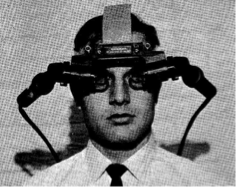
[Fig. 5]. A scientist of the future records experiments with a tiny camera, fitted with a universal-focus lens. The small square in the eyeglass at the left sights the object. Life Magazine, September 1945. (Reprinted from The Atlantic Monthly, July 1945.)
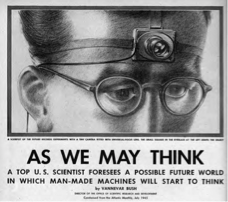
[Fig. 6]. A few years after its publication in 1964, Bush’s essay inspired Ivan Sutherland to create the Sketchpad (a.k.a. Robot Draftsman) system which established many of the early technologies for not only graphical user interfaces, but also CAD/CAM. In Bush, Vannevar, "Sketchpad: a man-machine graphical communication system," Proceedings of the SHARE Design Automation Workshop: 6-329 (1964).
The invisibility of certain forms of labor
Explainations from 1—7
1: Mouse tracking of BIM model inputs, 2: The message and Slack threads, 3: Version control analysis of drawing changes, 4: Phone Records, 5: Project schedules and timesheets, 6: Conversations with clients collected with text-to-speech, 7: Napkin sketches cataloged with machine vision
- KV
-
I know you’ve thought about how digital production and digital objects can actually have their own history of ideas and labor embedded within them. Can you describe that idea, and how you think about that?
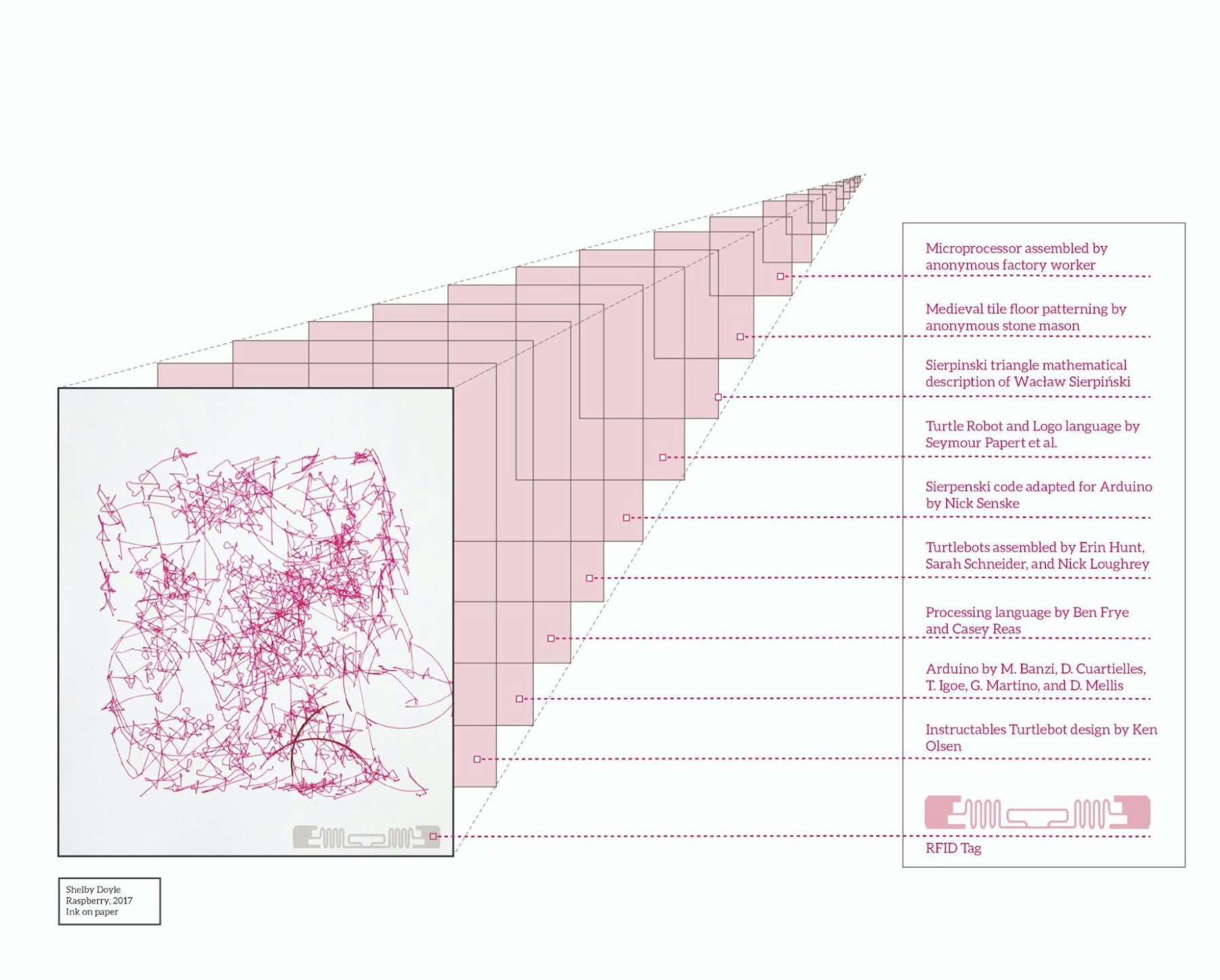
Figure 8. Speculative diagram illustrating the layers of attribution data contained within a drawing of a Sierpenski triangle produced with a Turtle robot accessible via an RFID tag embedded in the drawing. In Nick Senske and Shelby Doyle, "Digital Provenance and Material Metadata: attribution and co-authorship in the age of artificial intelligence." International Journal of Architectural Computing 16, no. 4 (2018): 271-280. © Doyle + Senske
- SD
-
I think mostly right now this remains a speculation. In reality it would mean something like mapping RFID tags onto every aspect of the built world, which is perhaps an unsatisfying realization of the collapse of the digital and physical world[4] (Figure 8). But as we continue to have more access to hyperlinks between the physical and the digital, in various forms of augmented realities that tie physical objects and digital information together, it means that you could know the entire history of something you're looking at: who worked on it, where it came from, where materials were extracted. For example, Kiel Moe wrote a book on the Empire State Building that looks at this idea of deep knowledge about a single building. This could be a way to intrinsically tie architecture to the history of its production or its labor and the extraction of its materials. I think that’s tough, because it really complicates things. It means there are no simple narratives, and as a designer you don't get to be on the side of the good and right.
I went to the University of Virginia as an undergraduate in architecture, and there’s a very complicated history of Thomas Jefferson and the enslaved laborers who constructed the University of Virginia. How does that, for example, change how we read the other aspects of how the Rotunda was built? And the other aspirations of UVA towards a notion of democracy and knowledge, which at the time was actually quite exclusionary and limited to white men. The Memorial to Enslaved Laborers, in a way, becomes a hyperlink where you can't ignore the history of the labor associated with the Rotunda. What if that were something we used as a term of evaluation for all architecture projects? If we said no, you’re not going to win an award if people on this job were underpaid or didn’t have access to health insurance, or…?
For example, I think if any of us have to really talk about where the materials for our computers are mined, it opens up a discourse about the ways that architecture is engaged with flows of money, people, and materials—far beyond just the representational aspects. The issue being that architecture has legally said that architects are not responsible for “means and methods.” If you’re looking at the AIA contracts, these texts largely abdicate responsibility for construction. So I think this idea of having all these objects that are “talking” to you about how they are made would mean also really talking about architecture's relationship to construction—and in ways that I don’t know that we always do, because constructing reveals the distance between theoretical promises and everyday practice in architecture.
- KV
-
I think it’s really interesting the way your framing goes beyond just the indexicality embedded within a digital object, the way that Sterling described it in his idea of “spimes” in 2005, to embed not just the index and history, but also the cultural and social conditions—and their implications—that come along with that history.
- SD
-
And then I think there’s the inverse—it’s terrifying to think of every single thing that we're doing as being recorded. But now we live in the “Zoom world“ where every single thing is being recorded. It’s changed how we teach, work, and communicate. We already live in a world where our emails or text messages can be used in a legal sense. So we have, in many ways, already given in to recording our digital labor, whether we intend to or not. Perhaps now it’s more a question of, what do you do with that? It’s an astronomical amount of data. You could start to do something like recording keystrokes, but there would be massive downsides to recording every single thing that every single person did, and so I think that's why this isn’t a STEM project, it is a cultural history project. It does require the humanities, it does require storytelling and interpretation.
- KV
-
This question of labor and authorship is not just about new narratives. You’ve also talked about the implications of access to digital design knowledge. Can you talk about some of the systemic problems that you perceive regarding access to computational knowledge, especially for groups and individuals who have been historically left out of this trajectory?
- SD
-
These questions came out of looking around and asking, why is this happening? How have we ended up in a place where there's this very rarefied body of knowledge that's existing in a very specific set of people and institutions. My instinct was to look at the history, especially the history of computer science, when early computers, physical computers, were women: they were actually stacking punch cards and running programs. Culturally, what happened to change that? When we interviewed women who were in the early SOM computer group, one of the most fascinating things they said was that in early days, the male partners didn’t want to be involved in computers because computing meant typing, and typing was womens’ work [5][6] [Fig. 9]. So I think again, it’s that technology is very much culturally structured, and it isn’t this neutral thing that just sits there—and people approach it. It’s presented and packaged in very specific ways, as if it belongs to certain groups. So it’s that question of access: how do you keep someone from writing themselves out of a narrative that says, “I’m not a technology person” or “I’m not good with computers” or “I don’t have a place in that”? The systemic problems are well-documented, and so is the importance of representation, so if you don’t see yourself in the future, it’s hard to join that future. So when you do have the opportunity to present a different version of the future, then you do that [Fig. 10].

Figure 9. SOM Chicago Computer Group, late 1980’s. Image copyright SOM. In, "SOM’s Computer Group: Narratives of Women in Early Architectural Computing," International Journal of Architectural Computing, 19, no. 3 (2021): 1478-0771. Courtesy of SOM © SOM.
Black: (F) Female, Grey: (M) Male
2012–2021
First Row 1–5
2012: (5 Total, 0 F, 5 M) 2013: (3 Total, 2 F, 1 M) 2014: (4 Total, 1 F, 3 M)
2015: ( 6 Total, 1 F, 5 M) 2016: (5 Total , 2 F, 3 M)
Second Row 6–10
2017: (5 Total, 2 F, 3 M) 2018: (5 Total–1 F, 4 M) 2019: (3 Total, 1 F, 2M)
2020: (21 Total, 18 F, 3 M) 2021: (21 Total, 13 F, 4 M)
- SD
-
So I think, on one hand, access is a representational issue—but then systematically, if it takes a million dollars to start up a robotics lab, is that something every single school needs to deal with at a practical level? And where does that knowledge live?
My colleague, Nick Senske, one of the cofounders of the CCL, both of us went to Ivy League graduate schools (MIT and GSD), and those are places with a very specific relationship to resources and to the type of knowledge that you're taught, and to what you’re expected to already know upon arrival. I think that’s been the most fascinating thing about becoming an educator is that there were a lot of times in my education where I was expected to know things like how to code, or how to use Photoshop, or how to 3D model. And no one taught that, because it was sort of dismissed as mere technical knowledge. The argument was if you need technical knowledge, go to a community college and take an AutoCAD class. And there was something belittling about that: the assumption that technical knowledge was lesser, and that it was intuitive. I think that that was really problematic because it assumes that you knew things like, why would anyone coming into architecture school know Grasshopper? There seems to be this culture of this hidden curriculum. Having to know things you can't know. That's what has been really fun about teaching undergrads—to ask how much we expect someone to know, even to be able to start. It's things that I had never thought to teach, like file structure layering, how to unzip a file, how to unblock a Grasshopper plugin, how to install a computer program. There’s also this narrative that students are digital natives and I think it's a really problematic way of looking at education because it says you don't have to teach it because they already know it. That’s a myth. Especially for my generation, which came up in hand drafting and then were part of the transition into the digital, so we are profoundly aware that these are learned skills. There is also this myth that being able to text and use your phone somehow prepares you for doing high-level computation. These are not the same. Being able to Snapchat and being able to organize a parametric file structure are not the same skillset. - KV
-
What I really appreciate about your work is that you’re not just recognizing the barriers and lack of access to technical knowledge, but you’re trying to come up with proposals for transforming this and finding more inclusive and distributive forms of knowledge. Specifically, I’m thinking about the proposal of a “circuit” that you and Nick Senske have developed.
- SD
-
When Senske and I arrived at Iowa State University in 2015 we began looking at how to integrate computation and digital fabrication into the curriculum. This was not new knowledge, it had existed at other schools for many years, but for us it was a question of where do you start? So much of the knowledge we had gained was from being in very specific institutions and from having social groups where we could just text and ask how to set up a robot. There’s this whole kind of body of knowledge that people don’t publish on because setting up a robot isn’t new knowledge. It’s what you do with it that's the new knowledge. But it also means that in order to even get to the new knowledge of doing things with a robot—that you're supposed to know how to set up a robot, code it, and then do something with it that no one has ever done. That means the distance between getting started, and that newness on which you can publish, becomes vast very quickly.
So the idea of the “circuit” is to ask, where does this information live? So that everyone’s not starting over and over. How are the systems of publication somewhat complicit in not making space for that kind of knowledge? The “circuit” was this idea that we don’t necessarily produce replicable scholarship in the same way that a scientific community does—computational design scholarship exists in a weird space between the humanities and the STEM fields; design scholarship—even technical design scholarship—is largely narrative. What would it mean if we all actually had to publish with the entirety of the process that went into it. So if you are doing 3D printed concrete, it’s not just the completed object, it’s also—how did you start? I think that Sasa Zivkovic at Cornell does a really nice job with this when they talk about the “Open Source Factory: Democratizing Large-Scale Fabrication Systems.”
The idea of the “circuit” is that the technical knowledge and the how-to is actually the responsibility of the community to share, because this demystifies computational design and opens up the proverbial “black box.”
- KV
-
This makes me think of an initiative developed by my colleagues Anya Sirota and Jacob Comerci at Taubman College called Source Material , which is a web platform that is a living collection of tutorials on software like Illustrator, Photoshop, rendering, Grasshopper, Blender, and it also includes things like tips and basic workflows. I’m thinking of a parallel one that could involve fabrication, different material techniques, different robotic techniques. Of course there are websites like Instructables, which is an amazing platform that helps to circulate the kind of tacit knowledge that comes through making and using technology.
- SD
-
I think academia has to change how it values knowledge creation. How does work that increases access to information create CV lines and other academic currency? It’s fascinating how we rank knowledge, and what that means.
I was influenced by taking “How to Make Almost Anything” at MIT’s Center for Bits and Atoms—and by the spirit of sharing technical skills between people and communities. That’s when this gets really fun—in those moments of collective making and collective history that maybe we take from things like craft, rather than from the science fields. Sitting together and making is the part of digital fabrication and studio culture that I think is even more valuable now that so much happens on the computer.
- KV
-
This counter-narrative of coauthoring, of making with humans and non-humans, is a central tenet in contemporary feminist theory. You've touched a little bit on that in your “Computational Feminism” essay, where you argue that computational feminism is not just about recognizing and acknowledging the female in this history, and making technology accessible to more than just privileged white males; it's also a kind of philosophical position on the post-human condition of the body— or the thing incomplete, imperfect, coauthored, and made with technology.
- SD
-
I think it goes to how we credit knowledge and the construction of knowledge. So much of the work that we're talking about here is a sort of digital or computational caretaking. Reading someone like Silvia Federici reveals this notion of what it takes to reproduce and sustain a society or a body of knowledge, and the type of work that is rewarded within that structure. For example, coauthoring and even trying to figure out how to acknowledge collaboration—that goes totally against the grain of the way that people are rewarded in the academy. You are promoted as an individual, you are tenured as an individual, and you're supposed to write an arc that talks about your unique indivisible contributions. The question is to keep interrogating why that continues and the ways that reproduces structures that maybe we're not trying to reproduce or were not aware we're reproducing? It would mean fundamentally changing how we reward production as a society. I don’t know if that's possible, but I think it's certainly rewarding to try to keep finding ways around, through, over, and under—what J. Meejin Yoon calls workarounds.
The thing that was fascinating when we were working on “Computational Feminism”—and since—is how much I learned from 1990s feminist and queer scholarship; how much work and thinking has already attempted to address these questions, and how architecture is coming to these questions twenty (thirty!) years later. Feminist and queer scholarship has really grappled with these ideas of distributions of labor and acknowledging the collective. These perspectives give architecture a way to think about these issues.
- KV
-
You’ve touched on a couple of key thinkers, artists, and practitioners. Who else are you currently looking at or reading that is influencing your thinking?
- SD
-
Race After Technology by Ruha Benjamin, Bauhaus Weaving Theory: From Feminine Craft to Mode of Design by T’ai Smith, Recoding Gender by Janet Abbate, Medieval Robots: Mechanism, Magic, Nature, and Art by E.R. Truitt, Staying with the Trouble Making Kin in the Chthulucene by Donna Haraway, Programmed Inequality by Mar Hicks… I could go on and on. I have a pile of books waiting for me to read them.
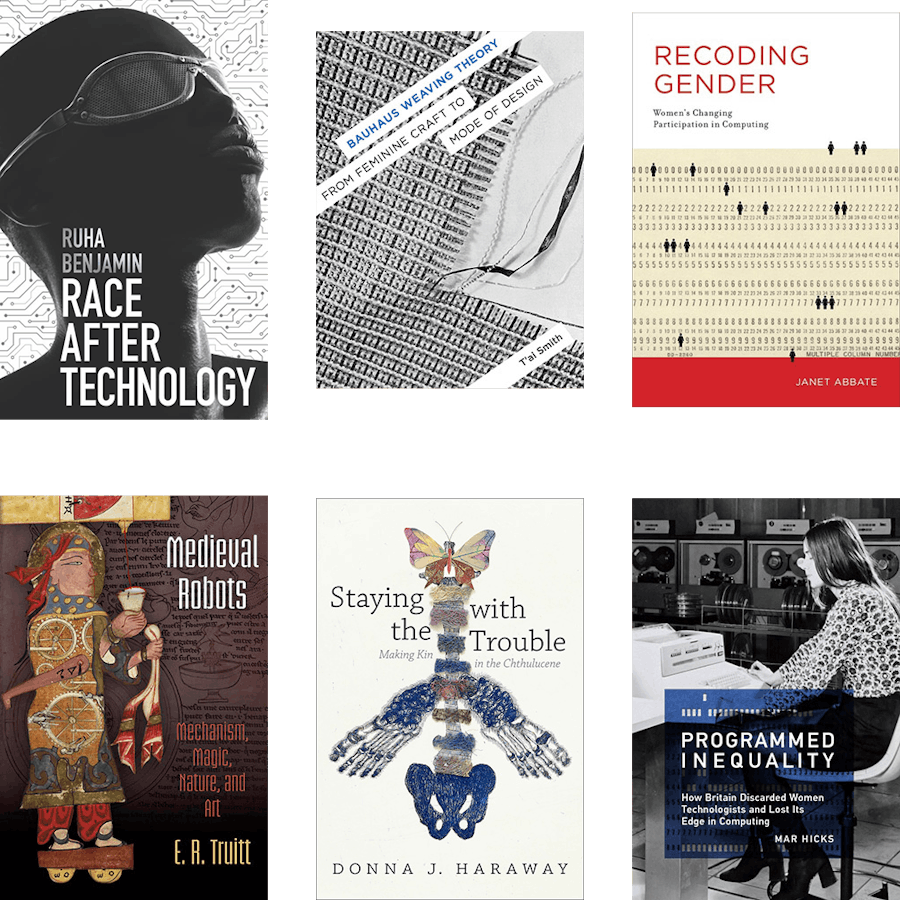
-
I’m currently part of a Mellon-funded project at the Canadian Centre for Architecture, The Digital Now: Architecture and Intersectionality, where I’m revisiting the exhibition archive for the Archaeology of the Digital through the lens of sympoesis. I'm approaching this work with the hypothesis that this method of working can take into account the power imbalances in architecture revealed by intersectionality, as well as create a means of “thinking-with” and “making-with” the construction of intersectional digital knowledge and computational labor in architecture. And it’s a really exciting opportunity to bring together several threads I’ve been working on during the past few years.
I’m thinking about how intersectionality and Kimberlé Crenshaw writing about intersectionality further complicates this narrative in a productive way; that feminism might be a body of thought rather than a specific or limited notion of gender or female bodies. And so thinking about Donna Haraway's most recent work when she talks about “sympoesis”[7] has been really productive, especially since the nation of “autopoesis” had become so caught up in parametric discourse, with [Patrik] Schumacker’s writing. Again, there are already these ways of thinking about the collective production of knowledge and work that exist outside of architecture, and so I’m thinking about sympoesis, and making with, and the idea that nothing itself generates or self-supports. I think it helps to get out of the trap of individualism. But, we still know that that's how work is rewarded, so it kind of puts us in this bind that I don’t have an answer for but I’m excited to keep thinking about. - KV
-
Any parting advice on how to go about changing some of these practices, these habits, these assumptions that are systemic and still so pervasive. Besides reading theory, what else can you do? Especially as architects, who always want to be doing or making something?
- SD
-
The way I’ve tried to engage with these questions is in everyday practices, and thinking about changing how I teach, thinking about presenting these things that maybe I had to teach myself, that I know made it very stressful to try to learn software, for example. Talking about technology in that way that it's learnable and being very specific about that. Trying to generate cultures in my classroom where there's no shame for not knowing something, and trying to get everyone to understand that part of being part of a community means that sometimes you're going to be better at things than other people, and that we actually kind of need all these types of knowledge to exist.
I think the biggest thing for me has been—especially going from a student, to an educator, and through practice—to say: How did I get to this point? Where did this assumption come from? Then to question it, and then to figure out if I can act on it or not. That’s not something where you arrive at some perfect place. I think it’s a reminder that it's very much an everyday practice toward hopefully consistently improving and questioning how we think, work, and teach.
Sympoesis is a reminder that it matters what ideas we think with. It can be really exhausting to constantly ask why, to never be done, but doing that collectively can be an exciting and supportive practice.
